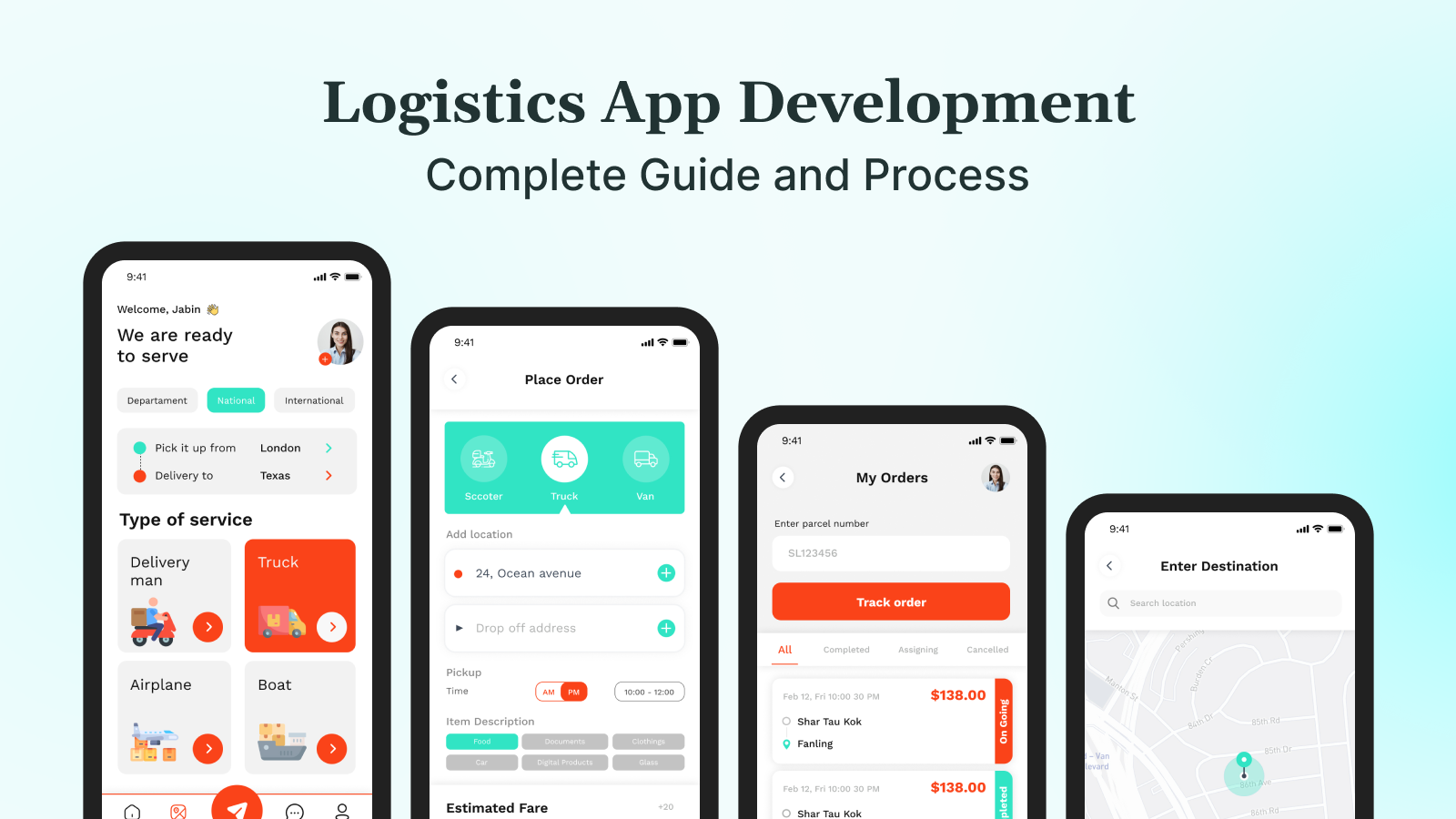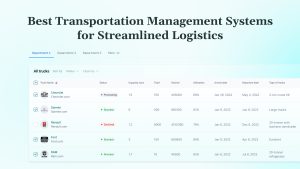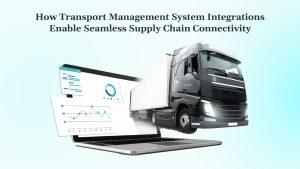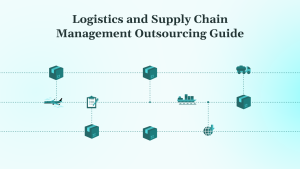Logistics apps are revolutionizing the supply chain and transportation industries by enabling real-time tracking, automation, and streamlined operations. The global logistics automation market is projected to reach USD 52.53 billion by 2029, driven by the need for efficient, technology-driven solutions.
As a logistics operator, tech entrepreneur, or software developer, creating a logistics app empowers you to optimize workflows, reduce costs, and enhance customer satisfaction in a competitive market. This comprehensive guide walks you through the process of building a logistics app, covering essential features, technology stacks, development steps, costs, challenges, and emerging trends for 2025. Let us get started.
Key Takeaways
- Logistics apps enhance supply chain efficiency with real-time tracking and automation.
- Include features like fleet management, delivery tracking, and customer order placement.
- Use React Native, Node.js, and PostgreSQL for scalable, cross-platform development.
- Overcome challenges like GPS accuracy and compliance with strong testing and design.
- Expect MVP costs to range from $25,000 to $50,000, and full solutions to range from $80,000 to $150,000.
What Is a Logistics App?
A logistics app is a software platform designed to optimize supply chain and transportation operations, enabling efficient management of fleets, deliveries, inventory, and customer interactions. It supports critical tasks, including real-time vehicle tracking, route optimization, warehouse management, and order fulfillment, while connecting stakeholders such as drivers, dispatchers, and customers.
B2B apps, such as fleet management systems, focus on operational efficiency for businesses, while B2C apps, like last-mile delivery platforms, prioritize customer-facing features like order tracking and ETA notifications. By centralizing data and communication, logistics apps reduce errors, enhance transparency, and streamline processes. Examples include Uber Freight for B2B freight tracking and DoorDash for B2C delivery.
Understanding the scope of logistics apps leads us to their key benefits for your business.
Key Benefits of Logistics App Development
Developing a logistics app offers transformative advantages for your operations, whether you manage a fleet, run a warehouse, or serve customers. These benefits enhance efficiency, reduce costs, and improve stakeholder experiences, positioning your business for success in a competitive industry.
- Real-Time Vehicle and Cargo Tracking: Utilize GPS to monitor fleets and shipments in real-time, ensuring timely deliveries and minimizing risks such as theft or delays, with live updates for all stakeholders.
- Optimized Delivery Routes and Schedules: Leverage algorithms to plan efficient routes, minimizing fuel consumption and delivery times, which can result in savings of up to 20% on operational costs.
- Reduced Operational Costs: Automate dispatching, tracking, and reporting to eliminate manual labor and administrative overhead, streamlining processes for both small and large operations.
- Centralized Communication: Enable smooth in-app messaging between drivers, dispatchers, and customers, reducing miscommunication and improving coordination across the supply chain.
- Enhanced Transparency and Customer Satisfaction: Provide customers with real-time order tracking and accurate ETAs, building trust and loyalty, especially in B2C delivery scenarios.
- Data-Driven Decision Making: Analyze delivery and fleet performance through integrated analytics, enabling you to optimize operations and predict demand with greater accuracy.
These benefits highlight the value of a logistics app, setting the stage for defining its core features.
Core Features of a Logistics App
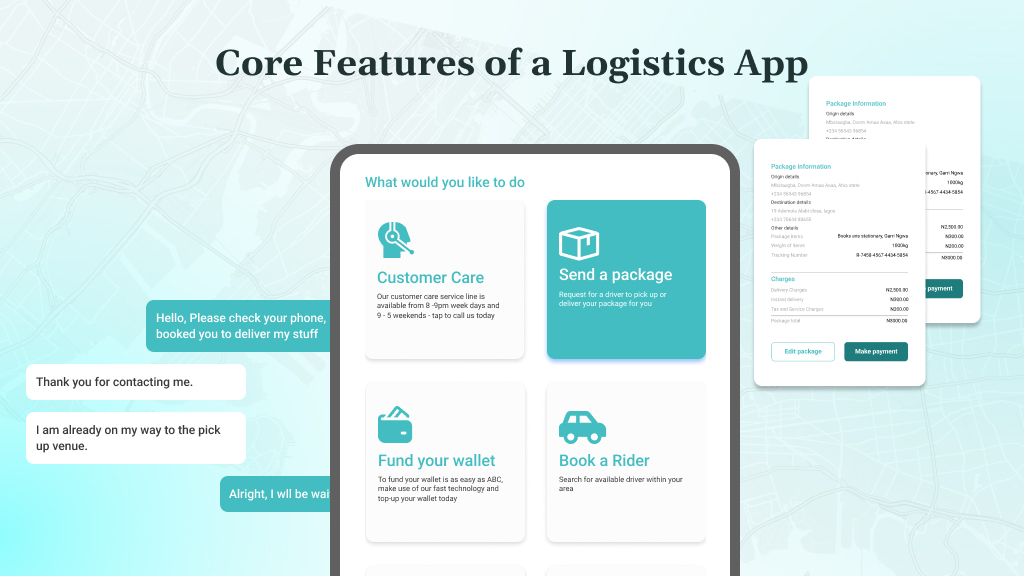
A robust logistics app requires a comprehensive set of features tailored to the needs of administrators, drivers, and customers. These features ensure operational efficiency, user satisfaction, and seamless communication across all user roles, making your app a valuable tool in 2025’s logistics ecosystem.
For Admin Panel
- Fleet and Driver Management: Oversee vehicle maintenance schedules, driver assignments, and performance metrics to ensure optimal fleet operations and performance.
- Dispatch Control and Real-Time Tracking: Manage delivery assignments and track vehicles in real-time using GPS, with dashboards displaying status updates and any delays.
- Delivery Analytics Dashboard: Access detailed reports on delivery times, driver efficiency, and fuel usage to identify bottlenecks and optimize operations.
- Alert Systems and Notifications: Send automated alerts for delays, maintenance needs, or compliance issues to keep operations running smoothly.
For Drivers
- Job Assignments and Navigation: Receive tasks with optimized routes via Google Maps integration, minimizing travel time and improving efficiency.
- Delivery Status Updates: Update statuses such as “picked up” or “delivered” in real-time, ensuring accurate tracking for both admins and customers.
- Proof of Delivery Capture: Upload digital signatures, photos, or barcodes to confirm successful deliveries and reduce disputes.
- In-App Messaging with Dispatchers: Communicate directly with dispatch for real-time updates, such as road closures or customer requests.
For Customers
- Order Placement and Delivery Tracking: Place orders and track shipments in real-time, with a user-friendly interface for easy progress monitoring.
- ETA Notifications: Receive accurate estimated arrival times via push notifications or email, enhancing transparency.
- Digital Proof of Delivery: Access delivery confirmations, including signatures or photos, for verification and record-keeping purposes.
- Rating and Support Access: Rate driver performance and contact support for any issues, thereby improving service quality and fostering customer trust.
With your app’s features defined, let us explore the different types of logistics apps you can develop.
Types of Logistics Apps
Logistics apps vary based on their focus within the supply chain, each addressing specific operational needs. Choosing the right type ensures your app aligns with your business goals and target users, whether for internal efficiency or customer-facing services.
- Fleet Management Apps: Optimize vehicle tracking, driver scheduling, and maintenance, ideal for transport companies managing large fleets, like Ryder’s fleet solutions.
- Warehouse and Inventory Management Apps: Streamline stock tracking, order fulfillment, and warehouse operations to reduce errors in high-volume environments, as seen in apps like Fishbowl.
- Last-Mile Delivery Solutions: Focus on customer-facing delivery, offering real-time tracking and ETAs, similar to apps like DoorDash or Postmates.
- Freight and Cargo Tracking Apps: Monitor large-scale shipments across air, sea, or land, catering to global logistics providers like Maersk.
- Custom 3PL Platforms: Offer comprehensive end-to-end third-party logistics solutions, integrating warehousing, transportation, and customer service for businesses outsourcing their logistics.
Choosing the right tech stack can make or break your logistics app.With DEVtrust, you gain a partner who understands the nuances of scalable app architecture, real-time tracking systems, and secure integrations. Let us handle the complexity so that you can focus on growth.
Technology Stack for Logistics App Development
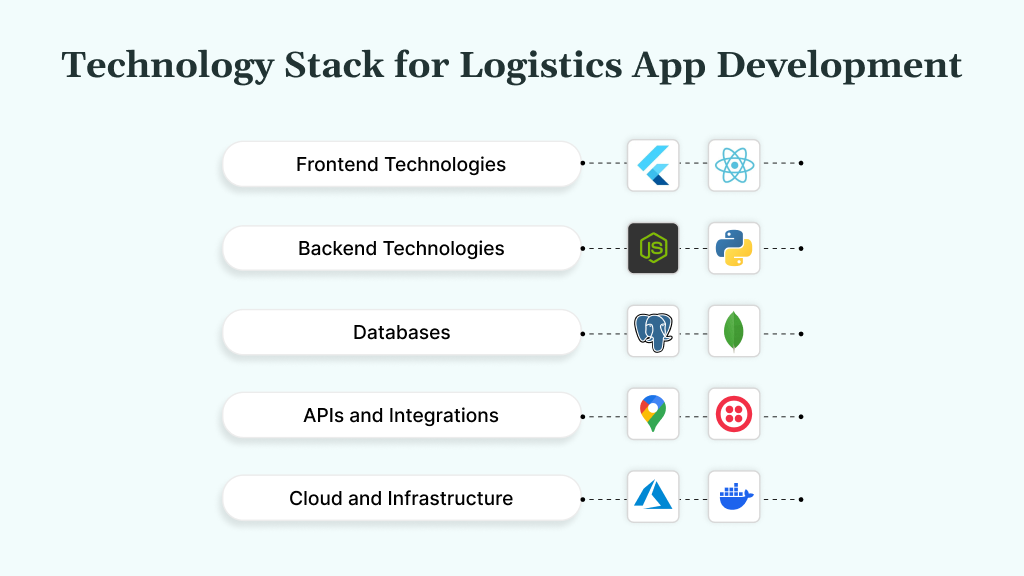
Selecting the right technology stack is critical to ensure your logistics app is scalable, reliable, and user-friendly. You need tools that support real-time data processing, mobile accessibility, and secure integrations to meet the logistics demands of 2025. This section outlines recommended technologies for each component of your app.
Frontend Technologies
- React Native, Flutter: Develop cross-platform mobile apps for iOS and Android with a single codebase, reducing development time and ensuring consistent user experiences.
- Angular, React.js: Build responsive admin web dashboards for real-time fleet monitoring, offering strong interfaces for complex data visualization.
Backend Technologies
- Node.js: Use with Express for fast, scalable server-side logic, ideal for handling real-time tracking and notifications.
- Python (Django): Offers secure, rapid development for complex logistics workflows, with built-in support for database management.
- Java (Spring Boot): Suits enterprise-grade apps, providing reliability for large-scale logistics operations.
Databases
- PostgreSQL: Handles structured data, such as driver schedules and order details, ensuring reliability and optimal performance.
- Firebase: Supports real-time data sync for tracking and notifications, ideal for mobile-first apps.
- MongoDB: Manages unstructured data like delivery logs, offering flexibility for diverse logistics needs.
APIs and Integrations
- Google Maps API: Enables route optimization and real-time tracking for drivers and customers.
- Twilio: Powers in-app messaging and notifications for smooth communication.
- Stripe/Razorpay: Facilitates secure payment processing for customer orders or driver payouts.
- IoT Sensors, ERP/CRM Integrations: Connects with IoT for cargo monitoring and ERP/CRM systems for business integration.
Cloud and Infrastructure
- AWS, Azure: Provide scalable, secure cloud hosting with compliance for logistics data.
- Docker and Kubernetes: Ensure consistent deployment and scalability for high-traffic applications, managing peak delivery demands.
With your technology stack chosen, let us outline the step-by-step process for developing your logistics app.
Step-by-Step Development Process
Building a logistics app requires a structured approach to ensure functionality, scalability, and user satisfaction. Each step (from planning to maintenance) is critical to delivering a reliable solution. Listed below are the five key steps to guide your development in 2025.
Step 1: Discovery and Planning
Define your business goals, such as improving delivery efficiency or enhancing customer transparency, and analyze competitor apps like Uber Freight to identify areas for improvement. Specify the must-have features for drivers, administrators, and customers, and define user roles. Create a project roadmap with timelines, milestones, and a budget estimate to align your team and stakeholders.
Step 2: Wireframing and UI/UX Design
Develop wireframes using tools like Figma to map out navigation flows for drivers, admins, and customers. Design intuitive interfaces, prioritizing mobile responsiveness and clear visuals for tracking dashboards. Test designs with potential users to ensure usability, focusing on simplicity for drivers and accessibility for customers.
Step 3: MVP Development
Build core modules, such as real-time tracking and order management, using your chosen stack, including React Native and Node.js. Set up backend infrastructure with PostgreSQL for data storage and integrate APIs, such as Google Maps, for geolocation. Implement notification services via Twilio to keep users informed.
Step 4: Testing and QA
Conduct unit testing for individual features, integration testing for API connectivity, and usability testing for user experience. Simulate real-world scenarios, like GPS signal loss or high delivery volumes, to ensure reliability. Perform load testing to confirm performance under peak demand using tools like JMeter.
Step 5: Deployment and Support
Launch your app on iOS, Android, and web platforms, ensuring compatibility with app stores and other relevant platforms. Set up analytics with Firebase or Mixpanel to track crashes and user behavior. Establish support channels for drivers and customers, and schedule regular updates to address bugs and add new features.
Logistics App Development Challenges
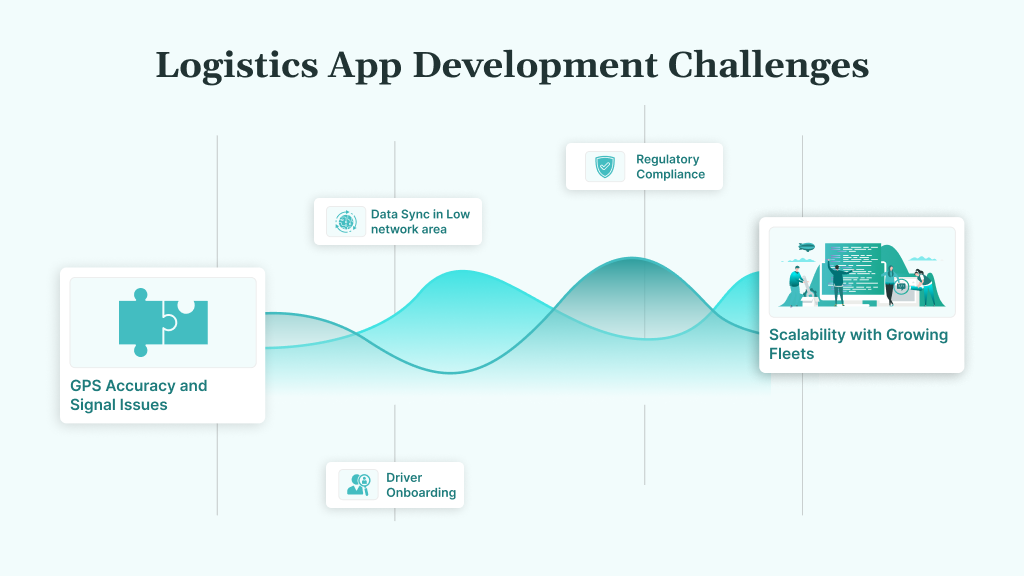
Developing a logistics app involves managing complex technical and operational hurdles. Understanding these challenges helps you plan effectively and deliver a reliable solution.
- GPS Accuracy and Signal Issues: Weak signals in rural areas can cause disruptions to tracking. Utilize offline caching and fallback GPS solutions to ensure continued functionality.
- Data Sync in Low-Connectivity Areas: Drivers may operate in areas with low signal strength. Implement local data storage and sync queues to ensure seamless updates.
- Regulatory Compliance: Transport and data privacy laws (e.g., GDPR) vary by region. Consult with legal experts and embed compliance features, such as encryption, early.
- Driver Onboarding and Training: Drivers may struggle with app adoption. Provide intuitive interfaces and training resources, such as video tutorials, to ease the transition.
- Scalability with Growing Fleets: High demand can strain systems, requiring strong solutions. Utilize scalable cloud solutions, such as AWS, and optimize database queries for optimal performance.
DEVtrust helped Moveit4U, an Australia-based TMS platform, transform an incomplete, underperforming codebase into a fully operational logistics app. By automating job creation from XML emails and integrating with the BOND carrier API, we enabled real-time status updates and streamlined dispatch.
Key outcomes included:
- 50% reduction in manual job creation efforts
- Real-time delivery tracking via carrier integration
- Support for multi-trip jobs with dynamic role-based dashboards
- Platform stability during a 45% surge in activity, with zero performance issues
Explore the full case study
Estimated Cost of Logistics App Development
Understanding development costs helps you budget effectively for your logistics app. Costs depend on app complexity, team expertise, and region, with additional expenses for maintenance and support.
- MVP Cost Range: $25,000-$50,000 for core features like tracking and order management, suitable for startups or small fleets.
- Full-Feature Solution: $80,000-$150,000 for advanced features like AI routing or IoT integrations, ideal for large logistics operations.
- Cost Drivers: App complexity (e.g., IoT support), developer rates ($30-$150/hour by region), and team size.
- Ongoing Costs: Maintenance, updates, and server hosting are a few annual costs you will incur.
Tips for a Successful Logistics App Project
A successful logistics app requires careful planning and execution to meet user needs and business goals. These tips help you avoid pitfalls and deliver a high-quality solution.
- Involve Logistics Professionals Early: Engage drivers and dispatchers in planning to align features with real-world needs, reducing adoption barriers.
- Focus on Driver User Experience: Design simple, mobile-friendly interfaces for drivers, minimizing clicks for tasks like status updates.
- Prioritize Reliable Real-Time Tracking: Ensure accurate GPS and backup systems to maintain tracking reliability in all conditions.
- Build Scalable Systems: Utilize a modular architecture and cloud hosting to efficiently handle growing fleets and peak delivery demands.
- Test with Real Scenarios: Simulate high-traffic deliveries or signal disruptions to ensure performance and usability under pressure.
Conclusion
Success in logistics today hinges on agility, visibility, and user-friendly tech. A custom logistics app provides you with the tools to monitor shipments in real-time, manage drivers efficiently, and keep customers informed, while controlling costs and scaling efficiently. DEVtrust specializes in developing custom logistics apps that optimize supply chains and enhance user experiences, utilizing technologies such as React Native, Node.js, and AWS to deliver scalable, secure solutions tailored to your business.
Our team integrates advanced features, such as AI routing and blockchain tracking, to ensure your app meets the industry demands of 2025. Partner with DEVtrust to transform your logistics operations. Contact our experts today to discuss your project, and we will build a solution that drives efficiency, reduces costs, and positions your business for success.
Logistics App Development: Complete Guide and Process
Streamline your operations with expert logistics app development. Explore real-time tracking, user management, and robust testing. Get started today!
Contact Us